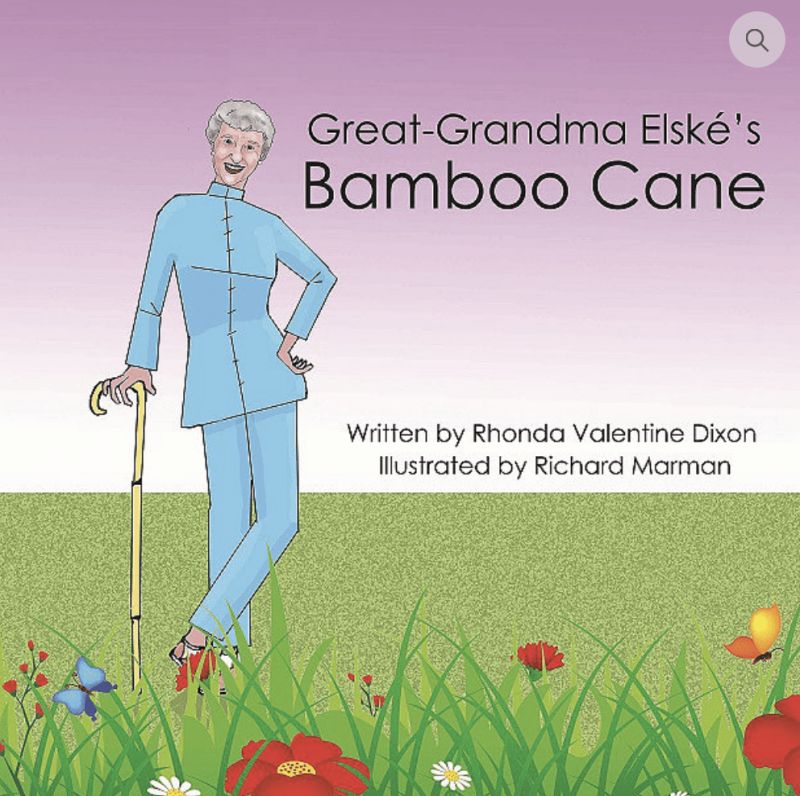

Yes, it’s true! My delightful children’s book is being re-released to coincide with Elskè’s one hundredth birthday.
Who’s Elskè?
She is the protagonist in the children’s book I published with Ocean Reeve Publishing in 2017.
Elskè was ninety-five when the story fell out of my head and onto the page.
This lovely lady is the oldest participant in our Tai Chi class, and she still practices Tai Chi every week.
We use walking-sticks and swords in Tai Chi.
In the story Elskè misplaces the cane she uses and we, her classmates, help her look for it.
I hasten to add that Elskè doesn’t need a cane to assist her mobility, though she tells me she’s having a bit of difficulty with her twirls these days.
What prompted me to write this story?
Elskè had owned the cane for well over fifty years, and it upset her greatly she had lost it. When we were crossing the street after looking for it in my car, she said she was so sad about losing it; she felt like she ought to confess to her mother. That’s when I knew I had to write the incident down. I knew right away it would be a children’s book.
I thought Elské’s statement was an extraordinary thing to say for two reasons. First, no matter how old we are, we are still someone’s child. The feeling of sadness Elskè experienced at the loss of the cane brought memories of childhood back for her. Memories of confessing to her mother for perceived losses or wrongdoings.
Second, it reminded me of the gentle, good-natured heart this woman has. We see it frequently in class, and when we meet outside of class. Our pre-arranged place for me to pick her up is usually under the tree where, she says, the Sergeant Major kissed her in 1942. Now, I know her husband was an acting sergeant, not a sergeant major, so I had to seek clarity on the issue. Evidently, there was a song from the era that inspired her to use those words, and now all her friends know which tree she’s referring to. I think it was a delightful thing to say in a world in which crass words in popular music and television programmes bombard us daily, (if we let them.)
However, the statement Elskè made as we crossed the road was the only part of the story I didn’t put in the book. How could I explain to three-year-olds that a ninety-five-year-old lady could have a mother at home? But it was okay; there was still much to say.
I need to mention that this cane is not just used in Tai Chi. It has a second purpose. I reveal this at the end of the book. And I can tell you from having seen it myself, the second purpose really is as I have written.
What’s in it for you when you buy this book?
This is not just a delightful children’s story describing an incident that happened at Tai Chi. It embraces principles in the Early Years Learning Framework of Australia and the Te Whāriki early learning framework of New Zealand,
Some of these principles are:
From Australia’s Early Years Learning Framework
- Secure, respectful, and reciprocal relationships
- Respect for diversity
The members of the class are not ‘put out’ by Elskè’s distress. They are not impatient with her. They help her look for the cane. There is respect and giving in their relationships. And the diversity is evident in how the classmates delight in and appreciate the family tradition that Elskè established for the cane over fifty years before.
And from Te Whāriki we see:
New Zealand’s curriculum promotes respect for diversity (because Aotearoa/New Zealand is a bicultural society.)
However, in Great Grandma Elskè’s Bamboo Cane, I am illustrating diversity by showing children that elderly people can successfully participate in community activities—and enjoy the pursuits they engage in. A diverse range of students, both in terms of age and cultural background, enjoy Tai Chi at the school Elskè attends.
Family, whānau and community—a child’s family, whānau and community are recognised as part of the learning experience.
Harriet sees her great-grandmother perform Tai Chi for the first time, and it impresses her.
And the community sees the tradition Elskè established over fifty years before and appreciates what a delightful family custom it is. It is as sweet today as it was in the 1960s.
Children can also see where they fit in within a family. Harriet’s grandmother, Jennifer, takes Harriet with her when she collects Jennifer’s mother, Great Grandma Elskè from Tai Chi. Harriet can regularly see the three generations that precede her. (Although I don’t mention Harriet’s parents in the book, clearly she has some or she wouldn’t exist.)
Even when I launched this book, Elské’s family showed me why they are all so successful in life. They live by those principles we see in the early learning frameworks of the two countries.
Elskè’s grandson (an internationally accomplished musician) played the soundtrack for the event and he incorporated into the music he played, pieces his grandmother Elskè had taught him when he was a little boy.
Who illustrated the book?
Richard Marman is an author/illustrator/artist/musician who lived long enough in his homeland to gain a classy British accent. However, I think he’d consider himself Australian now, since he’s lived here for much of his life. He trained as a pilot with the RAAF and piloted helicopters and a C-130 Hercules transport before and during the Vietnam War. He later became a commercial airline pilot flying the Boeing-767 as a Captain. While training Singapore Airlines cadets to fly Learjets, he completed a Diploma of Commercial Art by correspondence.
Leaving aviation in 2006, he completed a degree majoring in creative writing and graphic design and a Diploma of Visual Art.
He has published eight novels, two novellas and two illustrated children’s books and illustrated over a dozen books by other authors.
The first time I read Richard’s work, I pictured kids sneaking a torch under the covers to continue reading way past lights out. Because he’s able to draw on his own actual life adventures, his books are compelling and fast-paced.
Richard introduced me to a way of illustrating that I was unfamiliar with when he created digitally, the pictures for Great Grandma Elskè’s Bamboo Cane. I have received many wonderful responses regarding Richard’s illustrations.
You can see Richard’s work at https://www.richardmarman.com/
Am I a children’s author?
I did not set out to be a children’s author. With kids’ books, every word needs to be important; have impact. I’m known for being a wordy person, so I surprised myself by creating a book for children. Now, I’ve written two children’s books with approval and encouraging words from my manuscript appraiser, however I still don’t feel I’m a children’s author. Both tales are stories that needed to be told. That’s all, really. There may be more kids’ stories that pop into my head and on to the page, though I’m not planning anything at this stage. I have yet to publish the second book.
It needs to be said that the books I’ve co-authored for autistic children, their parents and teachers, (one of which is illustrated by Richard Marman) do not fit into the children’s picture book category.
My writing journey continues.

